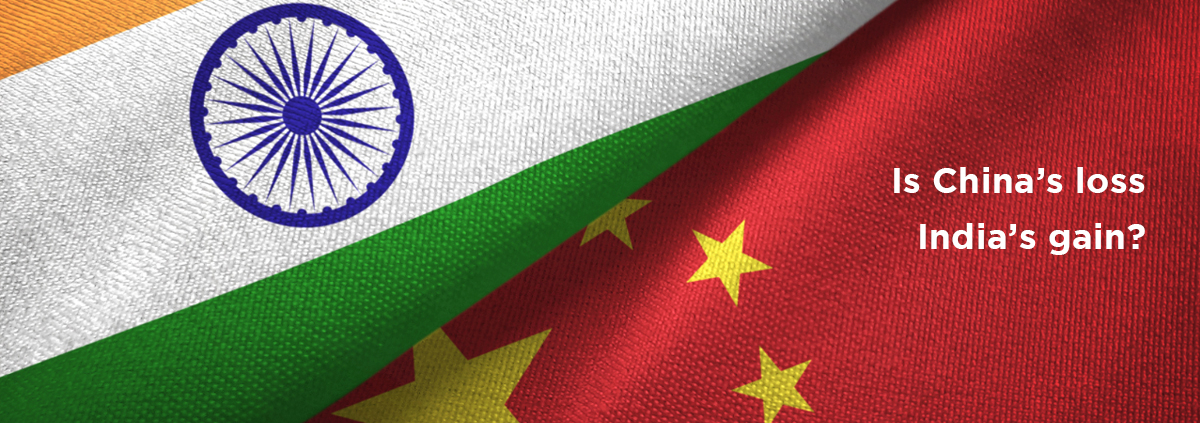What happens when a country which accounts for around 40% of global finished goods faces unprecedented backlash?
The way I see it, in today’s globalized economy, this means opportunity.
The country in question here is China, and it is on the verge of losing substantial business. By one estimate, around 33% of companies are currently moving their supply chains out of China(1). In fact, this trend has been underway since a decade. China once boasted ideal business conditions that led to its ascent up the value chain, turning it into “the world’s factory.” However, rising labour and environmental costs led to the first wave of exodus from China, a decade ago. This trend gathered momentum as the US-China trade war snowballed into a full-blown crisis in recent years, encouraging many big companies to devise an exit strategy.
It is worth noting that it was strictly business until that point. Nevertheless, in a survey conducted by the Pew Center in 2019, two-thirds of American respondents expressed an unfavourable opinion about China(2). In fact, the majority of respondents from the top ten economies did not view China in good light. Then, to make things worse, the Pandemic struck.
Since the COVID-19 outbreak, the negative sentiment towards China has reached an all-time high. Many countries – even important trading partners – are now seeking reparations, citing delayed first response and obfuscation of the truth by the Chinese Communist Party leadership. The CPC’s attempt at damage control through feigned goodwill has only made it worse, given the often faulty medical supplies it has shared with the rest of the world. The German government has publicly denounced China for soliciting letters of gratitude in return. The UK and France, who once had cordial trade relations with China, have expressed concerns over “wolf warrior diplomats” – a new brand of Chinese diplomats entrusted with pushing aggressive Chinese nationalist narratives around the world.
In December, 2019, when Wuhan-based doctors began to express concerns over a novel virus, China silenced them. Soon, the WHO downplayed the possibilities of human-to-human transmission, seemingly at the behest of China. Today, many administrators have a hard time comprehending how China has recorded merely around 4,600 deaths for a nation with a population of 1.4-billion, while the US has recorded 145,000 casualties. Most suspect under-reporting of numbers, insinuating lack of transparency in China, which extends across all facets of society, including the business ecosystem.
What amazes me most is that, despite drawing widespread flak over COVID-19 and associated issues, China has showed no signs of remorse or accountability. Instead, the CPC has stepped up its neo-imperialism and monetary hegemony. It has undertaken military drills in the South China Sea, in response to naval activity by QUAD members, drawing the ire of Vietnam and the Philippines, among others. Additionally, China’s crackdown on its Uyghur population is gaining mainstream attention, including recent scathing criticism from the US Secretary of State Mike Pompeo. Despite this, the CPC has gone ahead with imposing a new security law in Hong Kong, in a bid to quell the popular uprising in the region. In doing so, China is essentially acting like a rogue state, and needless to say, this has far-reaching implications.
Who will bell the cat?
In the contemporary business ecosystem, the lines between corporate culture and social responsibility are blurry. Consequently, brands like Nike and Apple are being increasingly urged by their customers to cut ties with China, owing to the latter’s gross violation of human rights. In response to such outrage many brands are seriously considering the re-shoring of supply chains, although this is not entirely down to ethical lines.
For instance: Before the pandemic, China produced half of the world’s masks. Since China faced the epidemic first, these supply lines were disrupted, leading to acute shortage of masks across the globe during the early stages of the spreading of the contagion. Conveniently, China capitalized on abundant stock for its own needs, and later sent substandard ones to other countries as a “gesture of goodwill”. These masks are only one among many other commodities where China had a virtual monopoly on production. Having learnt a lesson the hard way, companies and governments are looking to near-shore or restructure their supply chains.
Several ideas are brewing in business circles, as part of the larger supply chain risk mitigation process, but this is easier said than done. Japan, a nemesis of China, has earmarked $2 billion to relocate companies to Japan and an additional $200 million to get Japanese companies out of China and into other countries. The likes of Vietnam, Thailand, Mexico, Brazil and India are all in contention to land new contracts.
Google, Apple and Microsoft are among the leading companies contemplating an exit from China, taking some hardware production to alternative markets. However, shifting production can be a tall order compared to, say, re-shoring the assembly of components. Building the same capacity from the scratch requires time and resources. Most importantly, re-shoring warrants a transparent framework, reduced costs and economic resilience in the host country. Enter India.
Making a case for India
In the wake of the recent Galwan Valley clash, the already contentious relationship between India and China has boiled over, leading to a ban on several Chinese apps in India. But there is a catch: As I understand, nearly half of all unicorn start-ups in India are funded by Chinese investors, at least in part. Therefore, as much as we are compelled to float around hashtags saying ‘BoycottChina’ or ‘BanChineseProducts’, we must first understand the nature of the beast. China has deep-rooted involvement within Indian business ecosystem, much like MNCs do in China. So, even if a company is devising an exit strategy from China, this cannot realistically materialize before 2022, especially for major brands. Big industries have invested decades in building a robust supply system in China, and re-shoring entails exorbitant costs, which may not be feasible under current economic conditions.
Rumor has it that the Indian government has reached out to over 1,000 MNCs, offering attractive incentives to set up shop in India. The focus is on medical equipment, food processing, automotive components and textiles, where India, too, boasts a massive aggregate demand, complemented further by the steady growth in disposable income over the years. But the question remains: Is it enough?
We have to understand that China has a competitive edge in terms of speed, capability, logistics and value for money, which is not easy to replicate. Although India is competitive in terms of initial cost, affordable skilled labour, economic democracy and an English-speaking workforce, we must facilitate more favourable tax and labour laws. There are lingering concerns over India’s volatile FDI policies and complex, State-specific regulatory roadblocks.
It is a no-brainer that companies prefer near-shoring the supply lines instead of outsourcing. Therefore, to entice them, we need to table an offer they cannot refuse. Instead, the Indian government is preaching “vocal for local” and “Atmanirbhar Bharat,” which, although in the interest of India’s local producers, could discourage foreign companies. Such policies, and protectionism in general, could be a cause for concern for companies that are fleeing China for the same reason – economic nationalism. We should understand that, at a fundamental level, globalization warrants free-market policies. On the contrary, the Indian government’s new stimulus package has increased the threshold needed for foreign companies to bid for Indian contracts.
We are at a crucial juncture where every decision has a cascading effect. The government should make a demonstrable, commanding case, showing its intent to take over from China. As I see it, we are the front runners here — a claim substantiated in a Harvard Business Review article(3): In 2019, the US imported a whopping $452 billion of goods from China. Only five low-cost countries have GDPs larger than that: India, Mexico, Indonesia, Brazil and Thailand. India is the largest economy among the candidates, by a huge margin, besides being unparalleled in size and scale.
Also, India has substantiated its technical prowess and the ability to handle high-tech projects, as evident from ISRO’s collaboration with NASA for the NISAR project or Tata producing F16 wings for Lockheed. Unbeknownst to many end users, almost 40 percent of the generic drugs sold in the United States are produced in India. This is to say, Indian manufacturers are more prepared than ever to service first-world markets.
Recent months have seen the addition of many positives to this scenario. The likes of Facebook and Qualcomm have poured billions into Jio, while Google has announced $10 billion investments into India. Nevertheless, taking over China would mean that India would have to bridge significant gaps across governance, policies, investments, diplomacy, etc., while ensuring that misplaced nationalism does not lead us on to the same self-destructive path as China.
- https://www.gartner.com/en/newsroom/press-releases/2020-06-24-gartner-survey-reveals-33-percent-of-supply-chain-leaders-moved-business-out-of-china-or-plan-to-by-2023
- https://www.pewresearch.org/fact-tank/2019/12/05/people-around-the-globe-are-divided-in-their-opinions-of-china/
- https://hbr.org/2020/05/as-covid-19-disrupts-global-supply-chains-will-companies-turn-to-india



